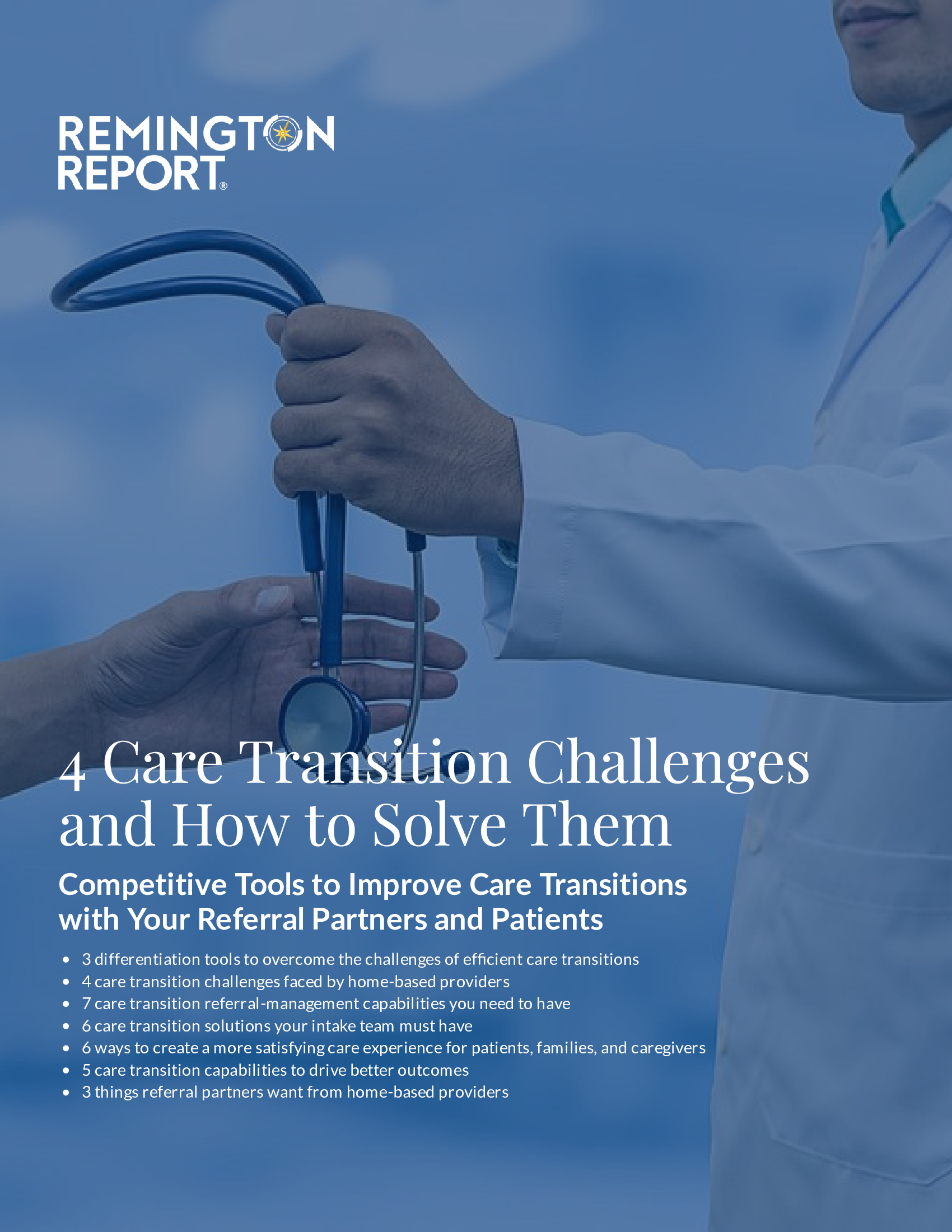Competitive Tools to Improve Care Transitions with Your Referral Partners and Patients
- 3 differentiation tools to overcome the challenges of efficient care transitions
- 4 care transition challenges faced by home-based providers
- 7 care transition referral-management capabilities you need to have
- 6 care transition solutions your intake team must have
- 6 ways to create a more satisfying care experience for patients, families, and caregivers
- 5 care transition capabilities to drive better outcomes
- 3 things referral partners want from home-based providers
Does your organization have these differentiation tools to overcome the challenges of care transitions?
- Imagine if your organization could have access to information about the care a patient has received no matter where the care was delivered within the care team.
- Imagine if your organization could access and share information before going to a patient’s home.
- Imagine that your staff could spend more time focused directly on the patient rather than on documentation. The entire care team – primary care providers, specialists, case managers, and more – would have secure, near-instant access to health information whether they’re in their offices or traveling to other locations.
In this special report are the challenges and solutions to effective care transitions, competitive tools, and shared peer actions.
Does Your Organization Have These 3 Differentiation Tools?
- Technologies that drive improved communications within your care team.
- Opportunities to drive competitive advantages with referral partners.
- Actionable steps to move forward within your own organization and other care providers.
4 Care Transition Challenges Faced by Home-Based Providers
Care Transition Challenge #1: Referral Partners Want to Know the Status of Their Patients
Patient care transitions have historically been a challenge in every care setting. Because of lack of information and the difficulty of sending information between providers, home health and hospice organizations have often struggled to obtain all the information they need to effectively care for their clients.
This transition process is often described as a “black hole” because complete patient information can be difficult to obtain, often leading to clinicians working with limited information, which can be dangerous. Accurate, up-to-date information is crucial for collaborating with referral sources to create appropriate plans of care and positively impact patient outcomes.
Conversely, hospitals and PCPs can struggle to see information from home health and hospice providers, leaving them in the dark about what’s currently going on with their patients.
With the push for more comprehensive care in the home setting, connecting the patient-care journey across the healthcare ecosystem is more important than ever.
Care Transition Challenge #2: The Manual Referral Process Eats Up Valuable Time and Frustrates Referral Partners
An everyday challenge: Communication with referral partners and other providers can sometimes be difficult.
Typically, when a referral is made to home health and hospice, sources either fax the information or a request is made for a liaison to physically pick it up. Once the patient data arrives in the home health or hospice office, it’s hand-keyed into the system, which is a time-consuming process (10 to 15 minutes per patient) that can lead to accuracy issues.
At the start of care, staff needs a variety of data to ensure intake is managed properly, including details on care needed (including reasons beyond the referral) and medication information from the previous care setting.
Does your organization have these seven care transition referral-management capabilities?
- Referrals from any certified EHR.
- Full clinical summary of the referring acute ambulatory encounter.
- Data reconciliation for demographics, medications, allergies, diagnosis, and more.
- The secure and healthcare-specific Direct Trust Network to message the provider.
- Documents that can be sent like email attachments, including plan of care, visit notes, orders, images, and scans.
- The option to embed documents in unstructured CDA.
- Text and document-based messages that can be added to a patient record.
Care Transition Challenge #3: Incomplete Access to Patient History Disrupts Care
A typical scenario: A clinician may drive out to a patient’s house, discover a shoe box full of medications, and they don’t know what that patient is supposed to be on. They don’t know what the rest of their problem was because they weren’t properly informed. So, what does that clinician do?
They spend the next couple of hours on the phone, talking with a referral source, talking with other specialists trying to reconcile that medication list, trying to complete the picture of what’s going on with that patient. In the meantime, they are not spending that time with the patient. They’re spending it on the phone. In hospice-based care, that’s the toughest day in the life of the patient and their family members who are present.
To improve care transitions, home-based providers need access to data from all previous encounters patients had with other providers, including allergies, medications, immunizations, procedures, and test results.
Does your intake team have these six care transition solutions?
For intake teams and admissions nurses, the right tools can transform a tedious manual process into an automated workflow.
- Documentation from previous care settings, not just the referring provider.
- History and physical documents.
- Encounter summaries.
- Continuity of care.
- Bi-directional connection to the network.
- Documentation that can be shared with other providers automatically, including C-CDAs, face sheets, visit notes, plans of care, orders, and scans.
Care Transition Challenge #4: Patients and Caregivers Want a Better Care Experience
Patients are waking up; they want assistance during their care journey in a patient-centric manner.
So much depends on the care experience your organization delivers: patient satisfaction scores, ratings, referrals, and retention rates. If you’re missing the mark, it can cost your business down the road.
Patients and caregivers today want the ability to communicate with their providers in real time, and their providers require a better way to share important documentation and collaborate remotely.
What are the six things your organization can do to engage patients, families, and caregivers for a more satisfying care experience?
- Communications to easily connect key stakeholders inside and outside your organization.
- Increase ratings, referrals, and retention rates by providing a more satisfying care experience for patients and families.
- Address issues and concerns in real time to ensure continuity of care and reduce unnecessary hospitalizations.
- Improve patient satisfaction scores and survey results with quick and easy access to caregivers, which can net more referrals.
- Provide easy access to caregivers to increase patient and family engagement, and boost ratings and referrals (research shows 96% of patients and families would choose a provider that does this well).
- Keep staff more satisfied with easy-to-use tools that reduce the administrative burden and give them more time to care for patients.
How Your Peers are Improving the Care Transition Process
Getting Accurate Patient History Prior To The First Visit

Vice President, Integrated Services
Mosaic Life Care
“A patient discharge for a hospital stay related to a fall may have a history of stroke, wounds, or other high-intensity care that home health will manage. With our technology partner, we can see the historical encounters of all participating acute and post-acute providers, not just the most recent discharge summary.”
Accurate information supports improved outcomes. Providing quality healthcare works best when you have the right information at the right time. Understanding a patient’s history – when they’ve been seen, why, where, and by whom – affects every aspect of the care you provide.
Because many patients receive care for multiple conditions and see different providers, it can be challenging to coordinate all the details of a patient’s health history.
Keeping track of medical records – including various diagnoses, treatments, allergies, medications, doses, and more – shouldn’t rely on a patient’s memory or require carrying copies of medical records from one provider to another. In an emergency, access to accurate information – especially if a patient is unable to provide it – can be crucial in making care decisions.
Improving Care Transitions with an ACO and Physician Network

Director Palliative Care Services
Iredell County Hospice and Palliative Care
“We partnered with a local ACO, a large physician network in our community, and that is when our program really started taking off. We were able to schedule monthly meetings to help them understand what we were trying to do. We shared all our data – good, bad, and indifferent – which helps you gauge where you’re going and what you’re doing. It also gives you marketing talking points for future referral sources.”
E-Referrals
Physicians can go into their EMR and do an electronic referral to us, just as they’re able to do an electronic referral to another consultative physician that is in their network. They do not need to fax. Their staff can go into their EMR and send that e-referral, all the information that we need for their last visit, and their medications. Their demographics then load into our system. It is an exceptionally smooth system, and it allows our intake staff to manage that referral very quickly, which creates a high level of satisfaction for our referral sources.
Direct Messaging with Our Referral Sources
It’s just as important for us to receive the information from the referral source, but it’s also especially important for us to be able to communicate our plans of care and our work with the patients back to those referral sources as quickly as possible. Direct messaging can be done very quickly. As soon as our provider closes that note from that visit, our staff can send that note directly back to the referral source, which means they can get that information on the same day. If that patient goes to see their primary care physician within a few days, they already know what our conversation was, what the goals of care are for that patient, what they want to discuss with that primary care physician, and that physician can be better prepared for the patient visit.
Improving Engagement with Patients, Families, and Caregivers

Director of Compliance
Sangre de Cristo Community Care
“My team has found so many creative ways to communicate, and we feel it’s just the beginning. It has made a major difference for us, eliminating the stress and emotions around obtaining necessary paperwork in trying times so that my team’s great work shines through instead. We’re extremely excited about this new tool that will further enhance our EHR experience and help take our organization to the next level.”
Sangre de Cristo Community Care, Southern Colorado’s leading provider of hospice and palliative care services, has found electronic forms management particularly helpful in onboarding hospice patients whose healthcare agents or proxy decisionmakers are out of state. Sangre staff can send a “magic link” that allows individuals to view, sign, and submit necessary forms without having to download a separate application, create a username, or jot down an email address or phone number.
Today, Sangre de Cristo has more than 70 types of electronic forms in its library, including both patient-facing forms, educational materials, and internal forms for workflows such as compliant investigations and information technology agreements. Currently, 96% of all Sangre de Cristo’s patient admissions forms for home health and hospice have been completed.
Patients and caregivers today want the ability to communicate with their providers in real time, and their providers require a better way to share important documentation and collaborate remotely.
Checklist for Improving Care Transitions and Better Outcomes
Does your organization have these five care transition capabilities to drive better outcomes?
- eReferrals: The ability to receive referrals via direct secure messaging is a great option for sending patient information such as demographics, medications, and allergies. This data should auto-populate directly into your EHR and be editable as needed. Clinicians need to be able to see this information at the point of care, so they can sit with the patient and reconcile the data accurately.
- Nationwide provider networks: With access to nationwide provider networks, such as CommonWell and Carequality, organizations should be able to query directly through their EHR for patient encounters with facilities or physicians and choose which associated documents to save to the patient record. This helps bridge the gap for any information that may have been excluded from the original referral. The EHR should also be able to contribute to the networks so that a provider or facility can run a query to obtain patient information related to their progress with home health or hospice plans of care.
- Surescripts: With this integration, post-acute clinicians can pull medication-fill history by date range for immediate, up-to-date information on prescription details and dosages. This date-filtered approach gives the nurse the information to educate the patient on appropriate dosing. This helps prevent patients from taking multiple doses of the same medication before and after their hospital stay, which is a frequent problem that can lead to an adverse event and even rehospitalization.
- Outbound direct secure messaging: Outbound direct secure messaging communication helps your organization stay in the loop after the patient transfers to home health or hospice. This also gives agencies a way to electronically send referrals to outpatient rehab or alternative living locations, often improving the back-and-forth referral relationship along the care continuum.
- Event notifications: This feature provides the ability to send and receive notifications to and from provider networks when a patient changes a care setting. In the past, care transitions were largely unknown, so this technology alerts the whole community of care providers on the provider networks with this information.
What Do Your Referral Partners Want from Home-Based Providers to Improve Care Transitions?
On average, 76% of health systems and physician groups would send more referrals to post-acute care providers that enable greater electronic data access, according to a survey. This is up from more than 60% of home-based care referral sources last year, underscoring the growing importance.
- Nearly 100% of acute and ambulatory providers are doing business electronically and expect their downstream counterparts in post-acute care to do the same.
- Only 14% to 15% of acute-care providers report being satisfied with their referral partners’ abilities to receive electronic referrals. Only 12% of skilled nursing referrals are currently sent through electronic data feeds.
- 95% of home-based-care respondents and 71% of skilled-nursing respondents acknowledged interoperability is important to their referral sources, up from only 34% of home-based-care respondents in 2021.










